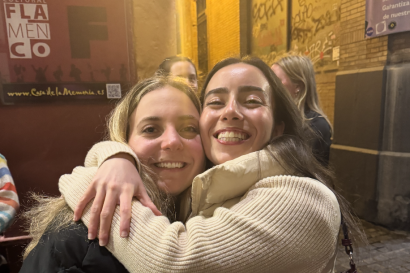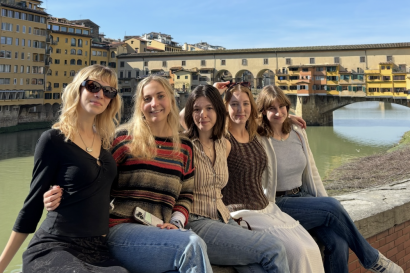
Looking at the massive structure of La Sagrada Familia from the outside, I saw an unfinished masterpiece overshadowed by cranes, scaffolding and the noises of a construction site. However, as soon as I stepped inside of Gaudi's cathedral, I had no words to say besides "wow" and nowhere to look besides up. Suddenly it was all silence as I stepped across the marble floors and watched the sunlight come in through the stained glass windows in every shade of orange and blue. The gothic columns imitated trees and shot up to the high ceiling above. I was simply in awe.
Barcelona has a unique style of architecture called “modernisme” that links the Catalan culture and history to art, materials and architecture. There is also an emphasis on handcrafted design, rather than mass-produced products. I was amazed when I learned about this style that is so specific to this region. Antoni Gaudi worked during the modernisme period, and he drew inspiration from both nature and religion, and was obsessed with the idea of handcraftsmanship because he believed in the beauty of imperfection.
So far during my time in Barcelona, I’ve had the chance to visit many of his projects. My three favorites have been La Sagrada Familia, Park Guell and Casa Mila.
I already described the inside of La Sagrada Familia with its nature-inspired tree columns, along with other organic forms Gaudi used. But the two outside facades of the building display Gaudi’s love of craftsmanship and detail. The stone faces were intricately designed to portray the birth of Jesus and his young life on the façade facing the rising sun, and his death on the façade facing the setting sun. It was then that I understood why the cathedral is still being built. Besides the construction of the monstrous building as a whole, those complex carvings on the facades took decades alone to perfect.
Park Guell is similar to La Sagrada Familia because it also draws its influence from nature. Gaudi mixed the idea of a park adapting to its Mediterranean surroundings with his fantastical imaginations. Eighty-six stone columns that rise up like tree trunks make up a forest, and other tree columns run throughout the park and hold up raised walkways where you can see views of the whole city. The more fantastical aspects are the gingerbread-like houses that look like they came straight out of a fairytale and also the long, mosaic-tiled bench. When I visited the park, a guitarist was singing a Spanish song underneath one of the many archways, and I loved getting to sit on one of Gaudi’s benches and listen to the music.
Casa Mila also combines the natural with the fantastical. The gargantuan apartment building is shaped like a giant wave and has iron seaweed balcony railings, an octopus-like door inside and blue murals on the wall as if it were underwater. Gaudi also copied many natural forms, such as a python skeleton, to construct the inside of the building, where he had also designed all the furniture—even down to the doorknobs and faucets. However, the rooftop of the building was the most interesting part for me because, among oddly shaped sculptures that are actually chimneys, I could see a 360 degree view of the entire city. I could even pick out my apartment building from high up above.

Abigail Summerville
<p>I'm excited to meet local people who have lived in Barcelona their whole lives who can tell me all about it- the history, culture, food, architecture, and the best places to visit. I'm also excited to meet the other students in the program and make lasting friendships. And I LOVE adventures, and can't wait to travel around Spain and to other countries as well.</p>








